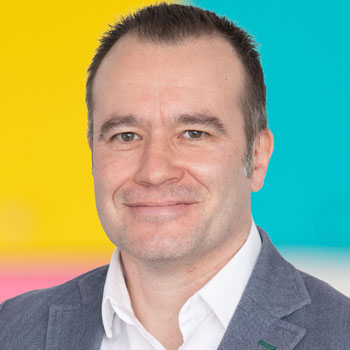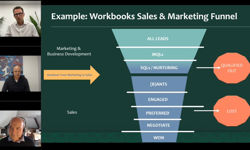
Incisive Media, the award-winning B2B services business with brands including Investment Week, Professional Pensions and Business Green, is well-advanced on a journey to provide marketing as a service. And Nexus, its next-generation Account-Based Marketing (ABM) product named Innovation of the Year at the PPA Awards in June, is proving to be a powerful engine.
“We want to be a partner not a supplier,” explains Paul Harvey, chief revenue officer of Incisive, which earlier this summer became part of Arc, the UK-based global data, events and media business previously best-known for its portfolio of agriculture titles, including Farmers Guardian and its associated events.
“A partner will help clients on the whole marketing mix, from research – when you are deciding what, who and why you are advertising – through how, the creative side, to the delivery of the assets – be that a piece of content, an ad or an article. We can help with all of that.”
Another part of being a partner is making ad content perform to the right audience – and knowing how to do that comes from experience and insight gained from past programmes and ongoing research.
Long term relationships
“We want clients to stay with us for a longer period of time,” Harvey adds.
“The majority of commercial programmes bought are bought in three-month bursts. We are trying to move away from that and encourage clients to use us as a publishing partner from the very start. So, marketing and performance is where we’re going.”

It’s all about creating better value for clients. And this means rewriting the traditional supplier / purchaser publisher / client relationship. And to this end, Incisive has invested strategically in skills and technology in recent years.
“Skills-wise, we’ve invested in content and design experts. Some of our customers – the likes of Schroders, Fidelity and BNY – have their own internal teams that create content, so we have to make sure ours is of a really high standard. And we’ve invested in a state-of-the-art studio from which we anchor more videos, webinars and events,” he explains.
“We’ve invested in our customer success team, which is now pivotal. We have grown it and strengthened the team of programme management experts who liaise with clients because we are encouraging so many different levels of interaction between more people within client organisations and more people within our own and managing all that is a real skill.”
The aim is to find ways to “buddy up” ever more closely with client teams.
“We want to work with as many people in a client organisation as possible – not only the front-end people. We want to embed our relationships with the client more and more deeply. Clients love to talk to editorial and to talk about their products and their story, but we want to identify what other important relationships there could also be,” he continues.
On the sales side, meanwhile, Incisive has invested to make sure its people “are able to talk and add value”, which means asking the right questions before and during a programme, Harvey adds: “Things can change, and we shouldn’t be shy of putting our hand up mid-programme and saying, ‘This could be better, let’s change it’ – that’s what proactive account management is about.”
Delivering insight
Hand in hand with better service these days goes better data, insight, and analytics, however – another key strategic focus for investment. Which is where Nexus comes in.
“Insight is what it’s all about today. Intent is where we’d like to move more into – giving clients more information about things like, what is a trend and what we have seen,” Harvey explains.
“Our move is towards more bespoke information for our clients and delivering more targeted customers. The value lies in layering data and information to see per client what assets people are downloading, what they’re reading, when and at what times – a real value proposition comes from all that, combined.”
And Nexus is the engine now powering Incisive’s delivery of that.
A while ago, Incisive started seeing more lead generation campaign briefs coming in with a long list of key accounts clients wanted to target. At a time when the number of ABM specialist competitors in the marketplace was growing, it was clear that Incisive needed to up its game.
“We needed to create something compelling and unique ourselves. We always had the right ingredients in-house but they weren’t pulled together as well as they could have been – Nexus was the answer,” he says.
Nexus offers clients a log-on dashboard displaying all their activity and related research quickly and easily in one place.
“Clients wanted more insight around programmes,” Harvey continues.
“Now we give them that – and more information around their targeted accounts. Nexus helps us create really good content messaging, because we know our audiences and what flies and because it helps us ensure that content is really relevant to target accounts and, also, each programme’s particular goal.”
If a client’s goal is to end up meeting ten individuals deeply engaged with its content over the preceding six months, for example, Nexus can help it identify those people, understand what content they engaged with most – and use this insight to help shape further content, then meet them, with Incisive’s delegate relations team working to ensure key people come to Incisive events.
“Incisive is all about putting buyers and sellers together,” he adds. “Nexus is all about improving your reputation, relationships and revenues with target customers.”
Incisive launched Nexus in April 2021 and Harvey, who took on his current role last year but has been with the company since 1999, says they’ve learned a number of important lessons over the months since.
Success factors
It is important to start a programme with a tightly focused target list – something Incisive can and now lobbies to help with at the earliest stage of any programme – because a common pitfall that can compromise effectiveness is setting out with a hit list that’s too broad, for example.
Knowing the key sales drivers is fundamental to getting the messaging right, he adds – so when it comes to understanding what really engages a target audience, talking to the sales team as well as the marketing department is key.
Understanding which channels and creative work best for what audience is a critical success factor – as is the willingness to change something that’s not performing as well as it could be, which depends on an ability to be flexible and sufficiently agile to move quickly.
Consistency is another essential, Harvey continues: “It’s important not to plan for a couple of months, but for the long term.”
Finally, there’s measurement. It is essential to agree a success metric together at the start and make the goal clear, then ensure everyone works towards it. And it’s also essential to measure all results and learn from them, being ready and willing if needed to optimise.
New beginnings
As well as the PPA Awards win, this year has been notable for the sale of Incisive’s finance and sustainability brands to Arc and, at the same time, the sale of its technology titles (which included Computing, CRN and Channel Partner Insight) to US-based The Channel Company.
Both acquiring companies are backed by investment funds managed by US-based EagleTree Capital. And the split is intended to support the growth of each group of products, Incisive Media CEO Jonathon Whiteley said when it was announced in June, in “a relevant and focused way”.
This year is shaping up well revenue-wise, too, with growth driven both by the bounce-back on the conference and events side of the business as well as new growth – in hybrid events, content and memberships. Meanwhile, digital ad revenue remains strong.
Yet despite this, there’s no time to rest on any laurels.
“In July, we had our Sustainable Investment Festival and in September, we’ve got our Net Zero Festival. Both are really popular among delegates and partners, and we really want to supercharge both next year – both from a physical and digital perspective, with a larger venue for a larger event, and making each more international,” he says.
Meanwhile, new products launching next year include Investment IQ, a new finance membership community whose members will get exclusive access to an array of white papers, fact sheets, and bespoke research. Incisive has recently been recruiting heavily to staff the community of existing and new contacts and service it once built.
“All the insights and analytics we will get from that will help fuel other products – ABM products and so on – so it will flow quite nicely with Nexus,” Harvey says, adding that he looks forward to exploring ways the model can be applied to building other membership communities around Incisive – and Arc’s – other brands.
With Nexus, meanwhile, the plan is to add more datasets in year two.
“Our data team is looking at how, as we are a year in with a year’s more data – not only on Nexus programmes but, also, other customers that have used us – we can now make comparisons to this year. This means we can add this layer of intent and behaviour on top of what we are already doing,” he says.
“The next step is to further power that up.”
The reason’s simple. In today’s fast-moving, highly competitive marketplace, client expectations have only one direction to go: up.
“B2B publishers need to create more value across the board for customers we want to pay for our content or who we want to share data exchange with for it, for those we hope to give up their time to come to our events, or to persuade those to leave their office at home,” Harvey concludes.
“To do all these things and to serve our commercial partners, who have loads of alternatives to reach their customers, we need to add more value – from knowing our audience and our customers better and better and from innovating, which we did a lot during the pandemic but which we now need to keep doing to keep that momentum going.”
This article was first published in InPublishing magazine. If you would like to be added to the free mailing list to receive the magazine, please register here.












